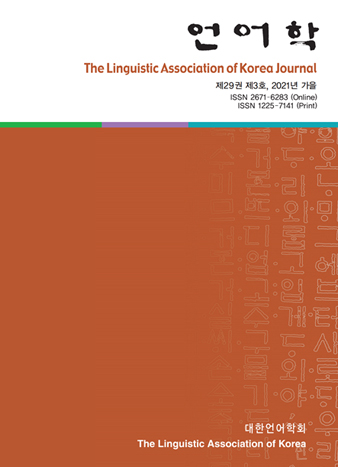대한언어학회 전자저널
29권 3호 (2021년 9월)
- An Optimality-Theoretic Account of Initial Sound Law in Korean, Revisited
-
Tae Sik Kim & Young-il Oh
Pages : 85-103
Abstract
Kim, Tae Sik & Oh, Young-il. (2021). An optimality-theoretic account of initial sound law in Korean, revisited. The Linguistic Association of Korea Journal, 29(3), 85-103. This paper investigates exceptions to Initial Sound Law in Korean within the framework of Optimality Theory. The law dictates that some nasal and lateral sounds not be in word-initial position. Even though a recent study (Oh & Kim, 2021) is able to cover fundamental cases of the law, many exceptions have still not been fully explained by the research, such as compounds, derivational words, proper nouns, numbers and bound nouns. Basically based on Oh and Kim (2021), we propose a revised constraint: a sonority difference between C and V in the initial position of a semantic unit should be at least 3 (CV SDiff (SUI ≥3)). With the notion of a semantic unit (instead of a word unit), the constraint interacts with other standard markedness and faithfulness constraints and clearly accounts for the limited distribution of the target sounds. The constraint ranking presented is as follows: *Complex (onset) >> Ident-IO (voice) >> CV SDiff (SUI ≥3) >> Max-IO >> Ident-IO (manner) >> CV SDiff (SUNI ≥3).
Keywords
# initial sound law # sonority # semantic unit # optimality theory
References
- Davis, S., & Shin, S. (1999). The syllable contact constraint in Korean: An optimality-theoretic analysis. Journal of East Asian Linguistics, 8, 285-312.
- Kager, R. (1999). Optimality theory. Cambridge: Cambridge University Press.
- Kang, H., & Lee, B. (1997). Generalized alignment and prosodic subcategorization in Korean. Japanese-Korean Linguistics, 6, 303-318.
- Kim, T. (2016). Bound nouns, ellipsis or pro-form. Studies in Generative Grammar, 26(1), 1-14.
- Kim, T. (2017a). Bound noun man in Korean. Studies in Generative Grammar, 27(1), 81-105.
- Kim, T. (2017b). Bound noun tongan in Korean. Studies in Generative Grammar, 27(2), 367-394.
- Kim, T. (2017c). The relationship between semantic bleaching and syntax: A case from bound noun cwung in Korean. Studies in Generative Grammar, 27(3), 565-589.
- Kim-Renaud, Y. (1974). Korean consonantal phonology. Unpublished doctoral dissertation, University of Hawaii.
- Oh, Y., & Kim, T. (2021). Hankwuke twuumpepchikey kwanhan choyceksengilon pwunsek (An optimality-theoretic accound of initial sound law in Korean.) The Journal of Linguistic Science, 97, 45-64.
- Park, I. (2010). L-nasalization, N-lateralization, and initial sound law: An optimality theoretic approach. Studies on English Language & Literature, 36(1), 245-258.
- Radden, G., & Dirven, R. (2007). Cognitive English grammar. Amsterdam: John Benjamins Publishing Company.
- Sohn, H. (1999). The Korean language. Cambridge: Cambridge University Press.
